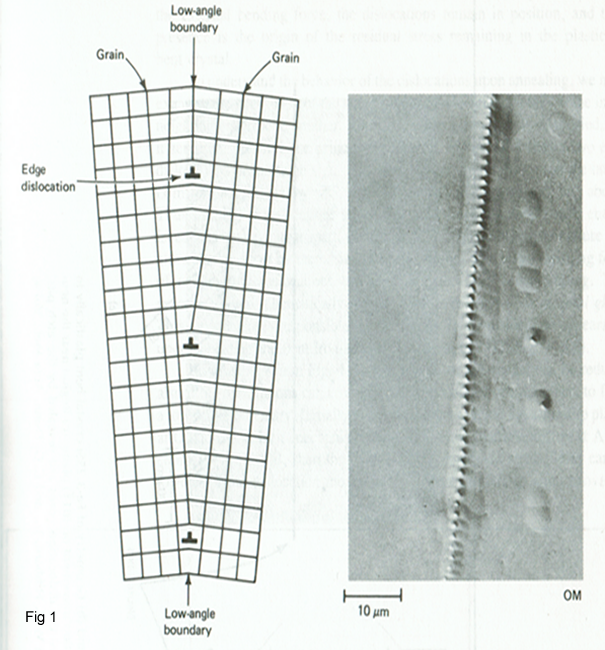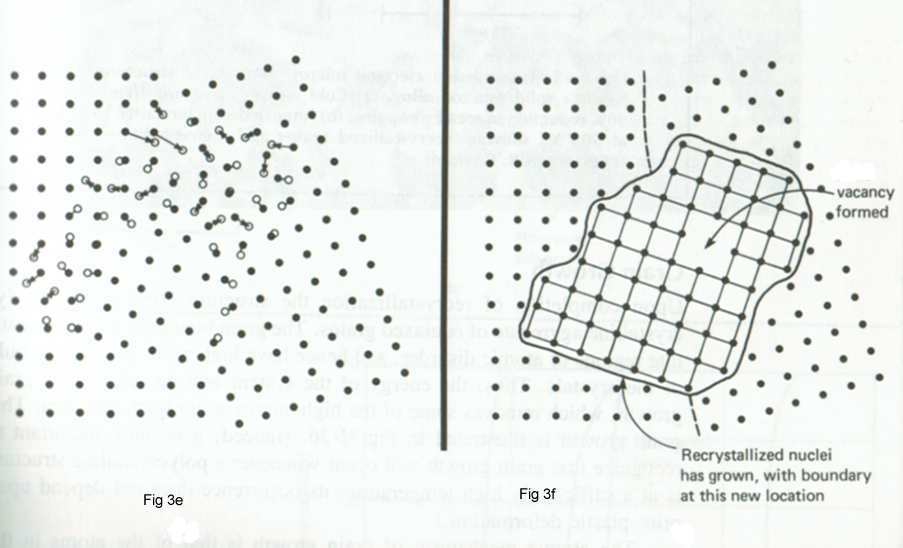Recovery, Recrystallization and Grain Growth
Recovery, Recrystallization and Grain Growth are microstructural changes that occur during annealing after cold plastic deformation and/or during hot working. When a metal is cold worked by plastic deformation, a small portion of the mechanical energy expended in deforming the metal is stored in the specimen. This stored energy resides in the crystals as point defects (vacancies and interstitials), dislocations, and stacking faults in various forms and combinations, depending on the metal ) .A cold-worked specimen, being in a state of higher energy, is thermodynamically unstable. With thermal activation, such as provided by annealing, the cold-worked specimen tends to transform to states of lower energies through a sequence of processes with microstructural changes.
The above three mechanisms are sometimes referred to as restoration processes, because they restore the microstructural configuration to a lower energy level. All three processes involve diffusion and thus depend on thermal activation to cause rearrangement of dislocations and grain boundaries. The mechanisms of recovery and recrystallization also depend on the extent of plastic deformation.
Recovery
When a strain hardened material is held at an elevated temperature an increase in atomic diffusion occurs that relieves some of the internal strain energy. Diffusion increases rapidly with rising temperature and this allows atoms in severely strained regions to move to unstrained positions. In other words, atoms are freer to move around and recover a normal position in the lattice structure. This is known as the recovery phase and it results in an adjustment of strain on a microscopic scale. Internal residual stresses are lowered due to a reduction in the dislocation density and a movement of dislocation to lower-energy positions. Recall that in crystals in which edge dislocation are arranged above one another, a misorientation exist between the two regions separated by the row of dislocations( fig 1).Such a row of dislocation is called a low-angle boundary, or a sub –boundary. Also by annealing after plastic deformation leads to a change of the dislocation microstructure and a partial restoration of material properties as before plastic deformation .There is no appreciable reduction in the strength and hardness of the material but physical properties such as electrical conductivity and corrosion resistance often improves.

We consider an alloy of copper with 5% Zn, which has been rolled at 25 oC. If the deformed alloy held at 400 oC, and hardness periodical measured, the data give curve such as shown in Fig 2.The annealing curve is divided into three regions, labelled recovery , recrystallization and grain growth .In the recovery stage the hardness remains constnt.This is followed by a drastic decrease in hardness during recrystallization .The hardness continues to decrease, but much more gradually, during grain growth.

Recrystallization
Recrystallization is a process by which deformed grains are replaced by a new set of undeformed grains that nucleate and grow until the original grains have been entirely consumed. Recrystallization is usually accompanied by a reduction in the strength and hardness of a material and a simultaneous increase in the ductility.
The beginning of recrystallization is illustrated schematically in figure 3.The nucleus is assumed to form in the vicinity of a grain boundary and two dislocations (fig 3a and fig 3b).A group of atoms rearrange themselves by a slight movement of each, forming a nucleus (fig 3c and fig3d) free of dislocation and having a different orientation from that of either original grain. Then this nucleus grows by the slight movement of atoms along the matrix-grain interface (fig 3e and fig 3f).



Grain Growth
If a specimen is left at the high temperature beyond the time needed for complete recrystallization, the grains begin to grow in size. This occurs because diffusion occurs across the grain boundaries and larger grains have less grain boundary surface area per unit of volume. Therefore, the larger grains lose fewer atoms and grow at the expense of the smaller grains. Larger grains will reduce the strength and toughness of the material.

